Illegal Selective Logging and Forest Fires in the Northern Brazilian Amazon
Abstract
1. Introduction
2. Materials and Methods
2.1. Study Area
2.2. Data Collection
2.3. Carbon from the Biomass Equation and the Use of the Correction Factor of the Dominant Height
2.4. Tree Mortality and Carbon Stock
2.5. Mapping of Illegal Selective Logging and Forest Fires with Claslite and INPE/Queimadas, and Restrictions due to Forest Physiognomy
3. Results
3.1. Forest Inventory (FI) and Timber Measurement (TM)
3.2. Tree Mortality and Forest Carbon Stock
3.3. Illegal Selective Logging and Forest Fires in the Southern Roraima
3.4. Fire Incidence in Roraima (2016 to 2017) and Flona Anauá
3.5. Accuracy Assessment of Mapping Performed by CLASlite
4. Discussion
5. Conclusions
Supplementary Materials
Author Contributions
Funding
Acknowledgments
Conflicts of Interest
References
- Lewis, S.L.; Edwards, D.P.; Galbraith, D. Increasing human dominance of tropical forests. Science 2015, 349, 827–832. [Google Scholar] [CrossRef] [PubMed]
- Lawrence, D.; Vandecar, K. Effects of tropical deforestation on climate and agriculture. Nat. Clim. Chang. 2015, 5, 27–36. [Google Scholar] [CrossRef]
- Aragão, L.E.O.C.; Anderson, L.O.; Fonseca, M.G.; Rosan, T.M.; Vedovato, L.B.; Wagner, F.H.; Silva, C.V.J.; Silva Junior, C.H.L.; Arai, E.; Aguiar, A.P.; et al. 21st Century drought-related fires counteract the decline of Amazon deforestation carbon emissions. Nat. Commun. 2018, 9, 536. [Google Scholar] [CrossRef] [PubMed]
- Chambers, J.Q.; Artaxo, P. Biosphere-atmosphere interactions: Deforestation size influences rainfall. Nat. Clim. Chang. 2017, 7, 175–176. [Google Scholar] [CrossRef]
- Wright, J.S.; Fu, R.; Worden, J.R.; Chakraborty, S.; Clinton, N.E.; Camille, R.; Sun, Y.; Yin, L. Rainforest-initiated wet season onset over the southern Amazon. Proc. Natl. Acad. Sci. USA 2017, 114, 8481–8486. [Google Scholar] [CrossRef]
- Artaxo, P.; Gatti, L.V.; Leal, A.M.C.; Longo, K.M.; Freitas, S.R.; Lara, L.L.; Pauliquevis, T.M.; Procópio, A.S.; Rizzo, L.V. Química atmosférica na Amazônia: A floresta e as emissões de queimadas controlando a composição da atmosfera amazônica. Acta Amaz. 2005, 35, 185–196. [Google Scholar] [CrossRef]
- Asner, G.P.; Knapp, D.E.; Broadbent, E.N.; Oliveira, P.J.C.; Keller, M.; Silva, J.N. Selective Logging in the Brazilian Amazon. Science 2005, 310, 480–482. [Google Scholar] [CrossRef] [PubMed]
- Condé, T.M. Avaliação dos Impactos na Vegetação após a Exploração Madeireira em Floresta Ombrófila Densa de Terra Firme Município de Caracaraí-RR. Master’s Thesis, Universidade Federal de Roraima, Boa Vista, RR, Brazil, 2011. [Google Scholar]
- Pereira, R., Jr.; Zweede, J.; Asner, G.P.; Keller, M. Forest canopy damage and recovery in reduced-impact and conventional selective logging in eastern Para, Brazil. For. Ecol. Manag. 2002, 168, 77–89. [Google Scholar] [CrossRef]
- Johnson, M.O.; Galbraith, D.; Gloor, M.; Deurwaerder, H.; Guimberteau, M.; Rammig, A.; Thonicke, K.; Verbeeck, H.; Randow, C.V.; Monteagudo, A.; et al. Variation in stem mortality rates determines patterns of above-ground biomass in Amazonian forests: Implications for dynamic global vegetation models. Glob. Chang. Biol. 2016, 22, 3996–4013. [Google Scholar] [CrossRef]
- Fearnside, P.M. Quantificação do serviço ambiental do carbono nas florestas amazônicas brasileiras. Oecol. Bras. 2008, 12, 743–756. [Google Scholar] [CrossRef]
- Nasi, R.; Putz, F.E.; Pacheco, P.; Wunder, S.; Anta, S. Sustainable Forest Management and Carbon in Tropical Latin America: The Case for REDD+. Forests 2011, 2, 200–217. [Google Scholar] [CrossRef]
- Asner, G.P.; Broadbent, E.N.; Oliveira, P.J.C.; Keller, M.; Knapp, D.E.; Silva, J.N.M. Condition and fate of logged forests in the Brazilian Amazon. Proc. Natl. Acad. Sci. USA 2006, 103, 12947–12950. [Google Scholar] [CrossRef] [PubMed]
- Nepstad, D.; McGrath, D.; Stickler, C.; Alencar, A.; Azevedo, A.; Swette, B.; Bezerra, T.; DiGiano, M.; Shimada, J.; Motta, R.S.; et al. Slowing Amazon deforestation through public policy and interventions in beef and soy supply chains. Science 2014, 344, 1118–1123. [Google Scholar] [CrossRef]
- Cochrane, M.A. Fire science for rainforests. Nature 2003, 421, 913–919. [Google Scholar] [CrossRef]
- Cochrane, M.A.; Laurance, W.F. Fire as a Large-Scale Edge Effect in Amazonian Forests. J. Trop. Ecol. 2002, 18, 311–325. [Google Scholar] [CrossRef]
- Van Marle, M.J.E.; Field, R.D.; van der Werf, G.R.; Wagt, I.A.E.; Houghton, R.A.; Rizzo, L.V.; Artaxo, P.; Tsigaridis, K. Fire and deforestation dynamics in Amazonia (1973–2014). Glob. Biog. Cycles 2017, 31, 24–38. [Google Scholar] [CrossRef] [PubMed]
- Barbosa, R.I.; Fearnside, P.M. Incêndios na Amazônia Brasileira: Estimativa da emissão de gases do efeito estufa pela queima de diferentes ecossistemas de Roraima na passagem do evento “El niño” (1997/98). Acta Amaz. 1999, 29, 513–534. [Google Scholar] [CrossRef]
- Barni, P.E.; Pereira, V.B.; Manzi, A.O.; Barbosa, R.I. Deforestation and forest fires in Roraima and their relationship with phytoclimatic regions in the northern Brazilian Amazon. Environ. Manag. 2015, 55, 1124–1138. [Google Scholar] [CrossRef]
- Fearnside, P.M.; Barbosa, R.I.; Pereira, V.B. Emissões de gases do efeito estufa por desmatamento e incêndios florestais em Roraima: Fontes e sumidouros. Rev. Agro@mbiente On-Line 2013, 7, 95–111. [Google Scholar] [CrossRef]
- Adeney, J.M.; Christensen, N.L.; Vicentini, A.; Cohn-Haft, M. White-sand Ecosystems in Amazonia. Biotropica 2016, 48, 7–23. [Google Scholar] [CrossRef]
- Guevara, J.E.; Damasco, G.; Baraloto, C.; Fine, P.V.A.; Peñuela, M.C.; Castilho, C.V.; Vicentini, A.; Cárdenas, D.; Wittmann, F.; Targhetta, N.; et al. Low Phylogenetic Beta Diversity and Geographic Neo-endemism in Amazonian White-sand Forests. Biotropica 2016, 48, 34–46. [Google Scholar] [CrossRef]
- PF, Polícia Federal. Operação Salmo 96:12 prende servidores federais. Available online: http://www.pf.gov.br/agencia/noticias/2012/maio/operacao-salmo-96-12-prende-servidores-federais (accessed on 23 April 2012).
- PF. Polícia Federal. Operação Xilófagos combate o avanço do desmatamento na Amazônia Legal. Available online: http://www.pf.gov.br/agencia/noticias/2014/12/pf-combate-o-avanco-do-desmatamento-na-amazonia-legal (accessed on 25 May 2015).
- IBAMA. Instituto Brasileiro do Meio Ambiente e dos Recursos Naturais Renováveis. O Ibama apreendeu 7.387 toras, o equivalente a cerca de 15 mil metros cúbicos de madeira, extraídas ilegalmente da Terra Indígena (TI) Pirititi, em Roraima. Available online: http://www.ibama.gov.br/noticias/436-2018/1434-ibama-apreende-madeira-suficiente-para-carregar-mil-caminhoes-em-rr (acessed on 3 May 2018).
- Brazil. Presidência da República. Lei nº 9.985, de 18 de julho de 2000 (SNUC). Available online: http://www.planalto.gov.br/ccivil_03/leis/l9985.htm (accessed on 7 May 2017).
- Costa, S.A. Diagnóstico da Extração Madeireira no Estado de Roraima; Monography, Universidade Estadual de Roraima: Rorainópolis, RR, Brazil, 2016. [Google Scholar]
- IBGE. Instituto Brasileiro de Geografia e Estatística. Manual Técnico da Vegetação Brasileira. Available online: https://biblioteca.ibge.gov.br/visualizacao/livros/liv63011.pdf (accessed on 7 February 2014).
- Higuchi, N.; dos Santos, J.; Ribeiro, R.J.; Minette, L.; Biot, Y. Biomassa da parte aérea da vegetação da floresta tropical úmida de terra-firme da Amazônia. Acta Amaz. 1998, 28, 153–166. [Google Scholar] [CrossRef]
- Silva, R.P. Alometria, estoque e dinâmica da biomassa de florestas primárias e secundárias na região de Manaus (AM). Ph.D. Thesis, Instituto Nacional de Pesquisas da Amazônia/Universidade Federal do Amazonas, Manaus, AM, Brazil, 2007. [Google Scholar]
- Lima, A.J.N.; Suwa, R.; Ribeiro, G.H.P.M.; Kajimoto, T.; Santos, J.; Silva, R.P.; Souza, C.A.S.; Barros, P.C.; Noguchi, H.; Ishizuka, M.; et al. Allometric models for estimating above- and below-ground biomass in Amazonian forests at São Gabriel da Cachoeira in the upper Rio Negro, Brazil. For. Ecol. Manag. 2012, 277, 163–172. [Google Scholar] [CrossRef]
- Gimenez, B.O.; dos Santos, L.T.; Gebara, J.; Celes, C.H.S.; Durgante, F.M.; Lima, A.J.N.; dos Santos, J.; Higuchi, N. Tree Climbing Techniques and Volume Equations for Eschweilera (Matá-Matá), a Hyperdominant Genus in the Amazon Forest. Forests 2017, 8, 154. [Google Scholar] [CrossRef]
- Condé, T.M.; Tonini, H. Fitossociologia de uma Floresta Ombrófila Densa na Amazônia Setentrional, Roraima, Brasil. Acta Amaz. 2013, 43, 247–260. [Google Scholar] [CrossRef]
- Higuchi, F.G.; Nakajima, N.Y.; Machado, S.A.; dos Santos, J.; Lima, A.J.N.; Higuchi, N. The use of Natural Fallen Trees in Mature Tropical Amazonian Forest for Volumetric Regression Analysis and Volume Equations Adjustment. Aust. J. Basic Appl. Sci. 2015, 9, 342–348. [Google Scholar]
- Woortmann, C.P.I.B. Equações Alométricas, Estoque de Biomassa e Teores de Carbono e Nitrogênio de Campinaranas da Amazônia Central. Master’s Thesis, Instituto Nacional de Pesquisas da Amazônia, Manaus, AM, Brazil, 2010. [Google Scholar]
- Soares, C.P.B.; Paula Neto, F.; Souza, A.L. Dendrometria e Inventário Florestal, 2nd ed.; Editora UFV: Viçosa, Brazil, 2011; pp. 163–174. [Google Scholar]
- Asner, G.P.; Knapp, D.E.; Balaji, A.; Páez-Acosta, G. Automated mapping of tropical deforestation and forest degradation: CLASlite. J. Appl. Remote Sens. 2009, 3, 033543. [Google Scholar] [CrossRef]
- INPE/Queimadas. Instituto Nacional de Pesquisas Espaciais/Programa Queimadas. Monitoramento de focos de queimadas no Brasil. Available online: http://www.inpe.br/queimadas/portal (accessed on 7 December 2018).
- Jensen, J.R. Introductory Digital Image Processing—A Remote Sensing Perspective, 2nd ed.; Prentice Hall: Upper Saddle River, NJ, USA, 1996; pp. 247–252. [Google Scholar]
- IPCC. Intergovernmental Panel on Climate Change. Climate Change 2014: Synthesis Report. Available online: http://www.ipcc.ch/ (accessed on 9 May 2016).
- Xaud, H.A.M.; Martins, F.S.R.V.; dos Santos, J.R. Tropical forest degradation by mega-fires in the northern Brazilian Amazon. For. Ecol. Manag. 2013, 294, 97–106. [Google Scholar] [CrossRef]
- Numata, I.; Silva, S.S.; Cochrane, M.A.; d’Oliveira, M.V. Fire and edge effects in a fragmented tropical forest landscape in the southwestern Amazon. For. Ecol. Manag. 2017, 401, 135–146. [Google Scholar] [CrossRef]
- Aragão, L.E.O.C.; Shimabukuro, Y.E. The Incidence of Fire in Amazonian Forests with Implications for REDD. Science 2010, 328, 1275–1278. [Google Scholar] [CrossRef]
- INPE/PRODES. Instituto Nacional de Pesquisas Espaciais/Programa de Monitoramento por Satélites do Desmatamento por corte raso na Amazônia Legal. Taxas anuais de desmatamento da Amazônia Legal do Brasil. Available online: http://www.obt.inpe.br/OBT/assuntos/programas/amazonia/prodes (accessed on 20 October 2018).
- Crivelli, B.R.S.; Gomes, J.P.; Morais, W.W.C.; Condé, T.M.; Santos, R.L.; Bomfim Filho, O.S. Caracterização do setor madeireiro de Rorainópolis, sul de Roraima. Ciência da Madeira 2017, 8, 142–150. [Google Scholar] [CrossRef]
- Souza, C.M.; Siqueira, J.V.; Sales, M.H.; Fonseca, A.V.; Ribeiro, J.G.; Numata, I.; Cochrane, M.A.; Barber, C.P.; Roberts, D.A.; Barlow, J. Ten-Year Landsat Classification of Deforestation and Forest Degradation in the Brazilian Amazon. Remote Sens. 2013, 5, 5493–5513. [Google Scholar] [CrossRef]
- INPE/DEGRAD. Instituto Nacional de Pesquisas Espaciais/Programa de Mapeamento da Degradação Florestal na Amazônia Brasileira. Taxas anuais de degradação da Amazônia Legal do Brasil. Available online: http://www.obt.inpe.br/OBT/assuntos/programas/amazonia/degrad (accessed on 20 October 2018).
- Colpini, C.; Silva, V.S.M.; Soares, T.S.; Higuchi, N.; Travagin, D.P.; Assumpção, J.V.L. Incremento, ingresso e mortalidade em uma floresta de contato ombrófila aberta/estacional em Marcelândia, Estado do Mato Grosso. Acta Amaz. 2010, 40, 549–556. [Google Scholar] [CrossRef]
- Laurance, W.F.; Nascimento, H.E.M.; Laurance, S.G.; Condit, R.; DʼAngelo, S.; Andrade, A. Inferred longevity of Amazonian rainforest trees based on a long-term demographic study. For. Ecol. Manag. 2004, 190, 131–143. [Google Scholar] [CrossRef]
- Higuchi, N.; Chambers, J.; dos Santos, J.; Pinto, A.C.M.; Silva, R.P.; Rocha, R.M.; Tribuzy, E.S. Dinâmica e balanço do carbono da vegetação primária da Amazônia Central. Floresta 2004, 34, 295–304. [Google Scholar] [CrossRef]
- Brando, P.M.; Balch, J.K.; Nepstad, D.C.; Morton, D.C.; Putz, F.E.; Coe, M.T.; Silvério, D.; Macedo, M.N.; Davidson, E.A.; Nóbrega, C.C.; et al. Abrupt increases in Amazonian tree mortality due to drought–fire interactions. Proc. Natl. Acad. Sci. USA 2014, 111, 6347–6352. [Google Scholar] [CrossRef] [PubMed]
- Morton, D.C.; DeFries, R.S.; Nagol, J.; Souza, C.M., Jr.; Kasischke, E.S.; Hurtt, G.C.; Dubayah, R. Mapping canopy damage from understory fires in Amazon forests using annual time series of Landsat and MODIS data. Remote Sens. Environ. 2011, 115, 1706–1720. [Google Scholar] [CrossRef]
- Silva, S.S.; Fearnside, P.M.; Graça, P.M.L.A.; Brown, I.F.; Alencar, A.; Melo, A.W.F. Dynamics of forest fires in the southwestern Amazon. For. Ecol. Manag. 2018, 424, 312–322. [Google Scholar] [CrossRef]
- Davidson, E.A.; Araújo, A.C.; Artaxo, P.; Balch, J.K.; Brown, I.F.; Bustamante, M.M.C.; Coe, M.T.; DeFries, R.S.; Keller, M.; Longo, M.; et al. The Amazon basin in transition. Nature 2012, 411, 321–328. [Google Scholar] [CrossRef]
- Brancalion, P.H.S.; Almeida, D.R.A.; Vidal, E.; Molin, P.G.; Sontag, V.E.; Souza, S.E.X.F.; Schulze, M.D. Fake legal logging in the Brazilian Amazon. Sci. Adv. 2018, 4, eaat1192. [Google Scholar] [CrossRef]
- Urquiza, M.A.; Melo, V.F.; Francelino, M.R.; Schaefer, C.E.G.R.; Souza, E.; Barbosa, R.I.; Santiago, M.M.; Araújo, T.H.C.; Maia, S. Anthropic Processes and Land-Use Change During 33 Years in Roraima, Northern Amazonia. J. Agric. Sci. 2018, 10, 426–442. [Google Scholar] [CrossRef]
- Barni, P.E.; Manzi, A.O.; Condé, T.M.; Barbosa, R.I.; Fearnside, P.M. Spatial distribution of forest biomass in Brazil’s state of Roraima northern Amazonia. For. Ecol. Manag. 2016, 377, 170–181. [Google Scholar] [CrossRef]
- Mendonça, B.A.F.; Fernandes Filho, E.I.; Schaefer, C.E.G.R.; Simas, F.N.B.; Vale Junior, J.F.; Lisboa, B.A.R.; Mendonça, J.G.F. Solos e geoambientes do Parque Nacional do Viruá e entorno, Roraima: Visão integrada da paisagem e serviço ambiental. Ciência Florestal 2013, 23, 427–442. [Google Scholar] [CrossRef]
- Barbosa, R.I.; Keizer, E.; Pinto, F. Ecossistemas terrestres de Roraima: Área e modelagem espacial da biomassa. In Roraima: Homem, Ambiente e Ecologia; Barbosa, R.I., Melo, V.F., Eds.; Fundação Estadual do Meio Ambiente, Ciência e Tecnologia (Femact-RR): Boa Vista, RR, Brazil, 2010; pp. 347–367. [Google Scholar]
- Novais, R.F.; Venegas, V.H.A.; Barros, N.F.; Fontes, R.L.F.; Cantarutti, R.B.; Neves, J.C.L. Fertilidade do Solo, 1st ed.; Editora SBCS: Viçosa, MG, Brazil, 2007; pp. 146–156. [Google Scholar]
- Nogueira, E.M.; Yanai, A.M.; Fonseca, F.O.R.; Fearnside, P.M. Carbon stock loss from deforestation through 2013 in Brazilian Amazonia. Glob. Chang. Biol. 2015, 21, 1271–1292. [Google Scholar] [CrossRef] [PubMed]
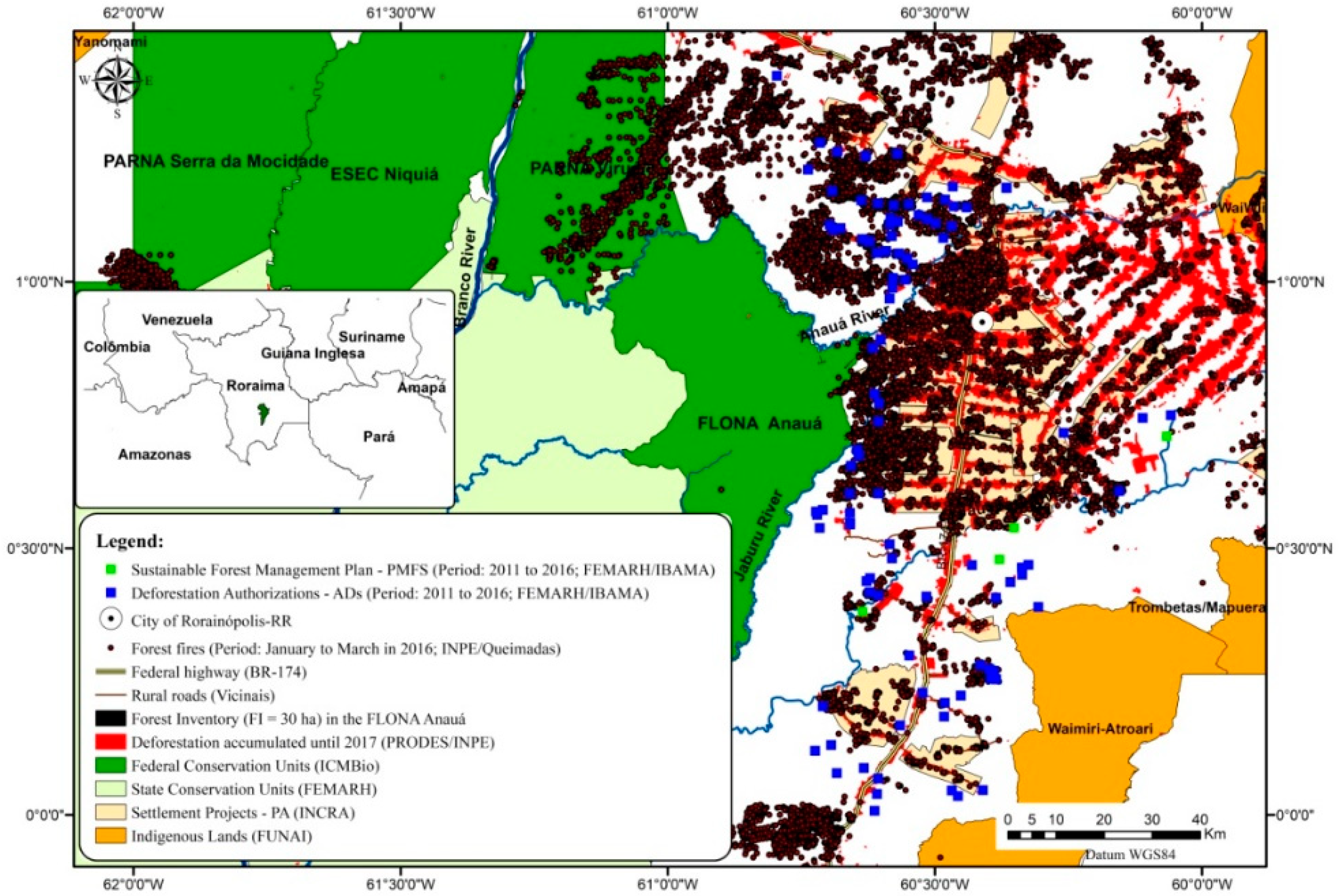
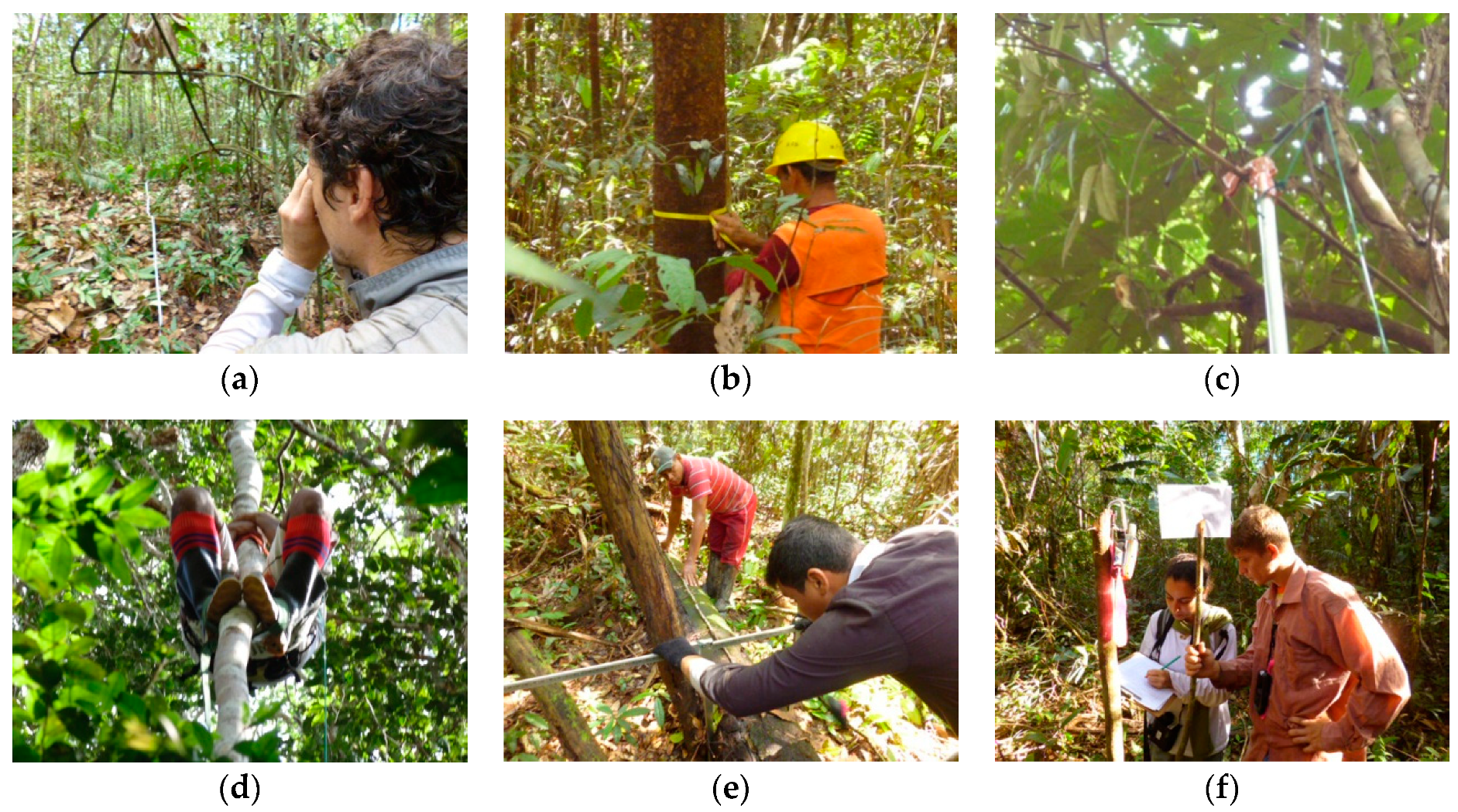
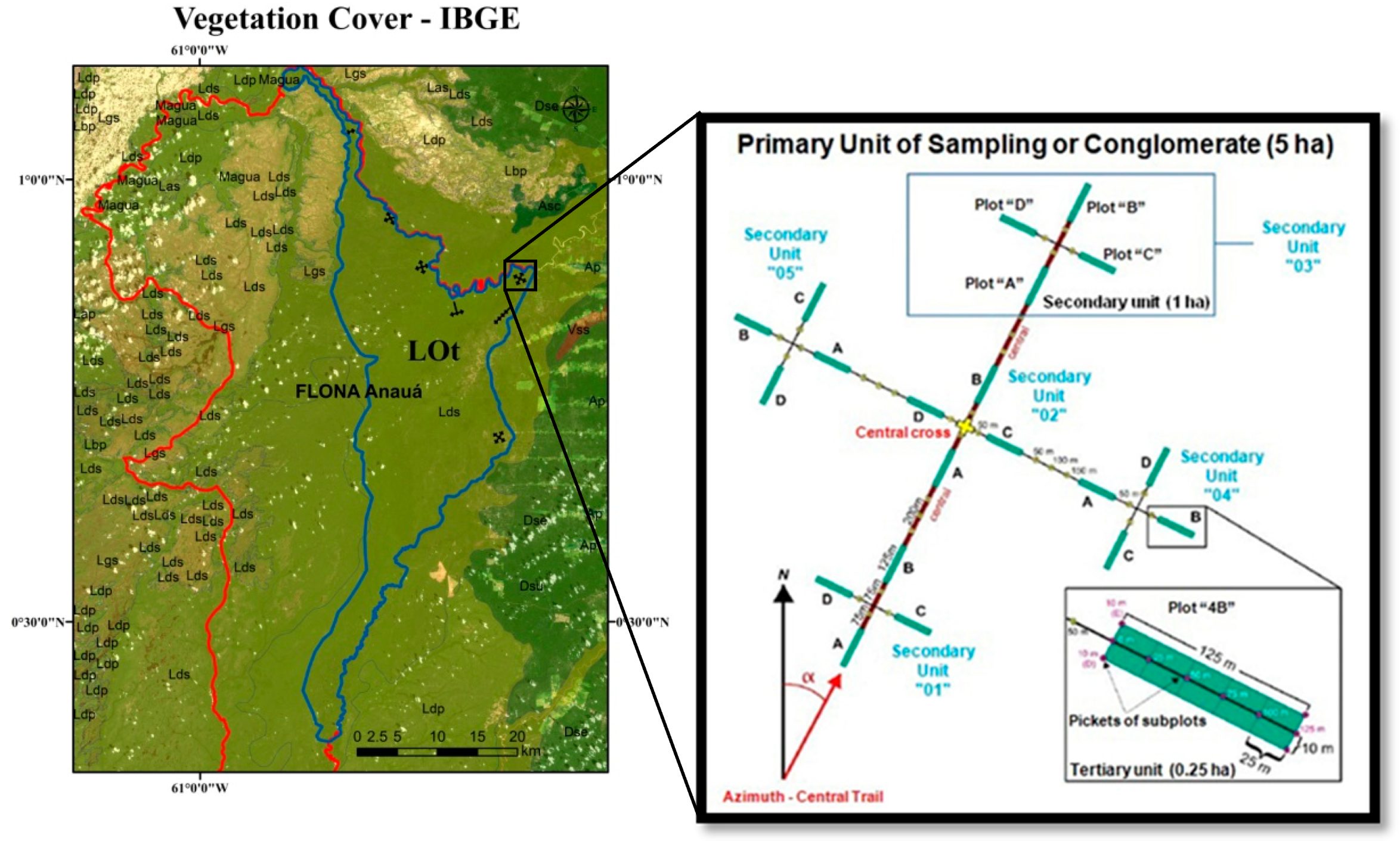
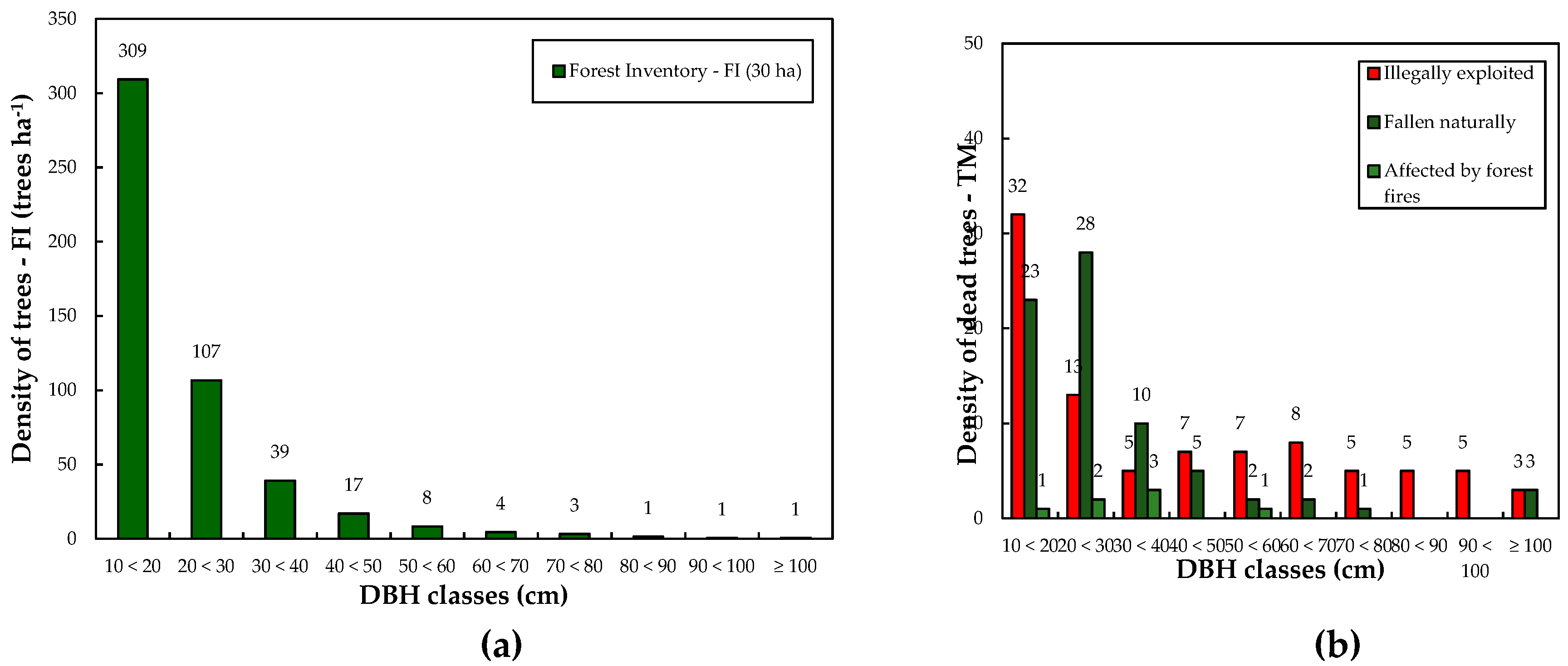
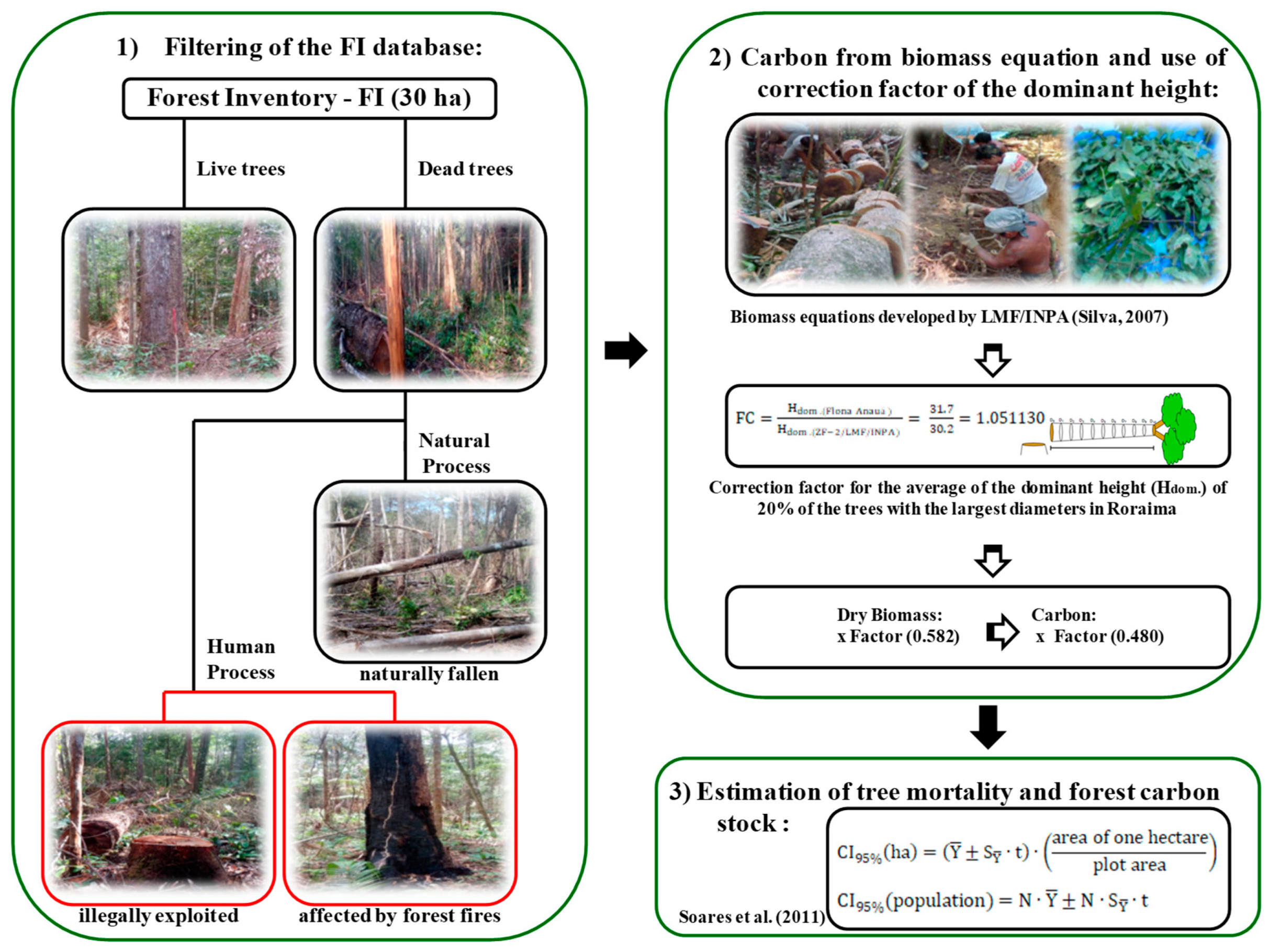
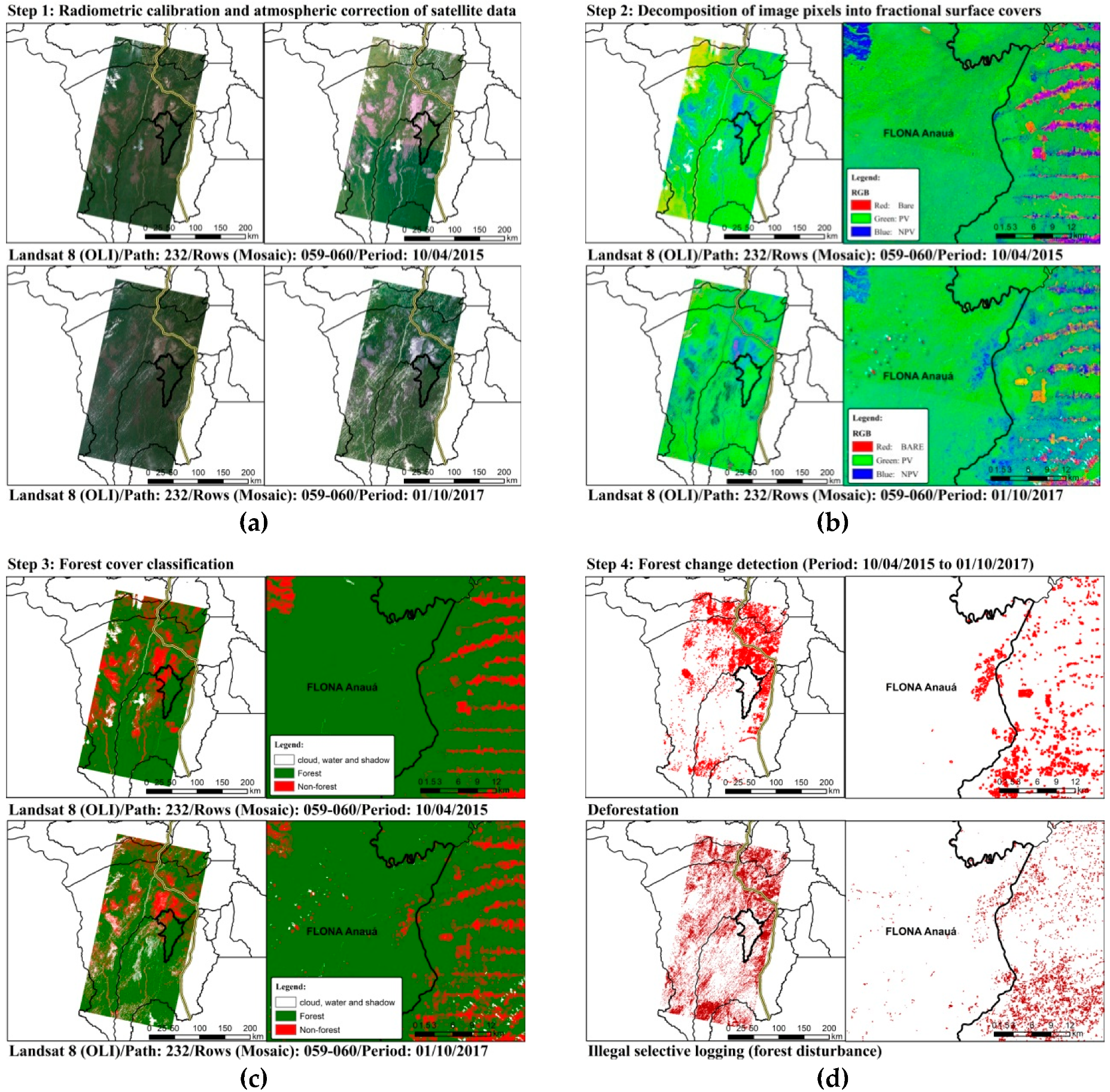
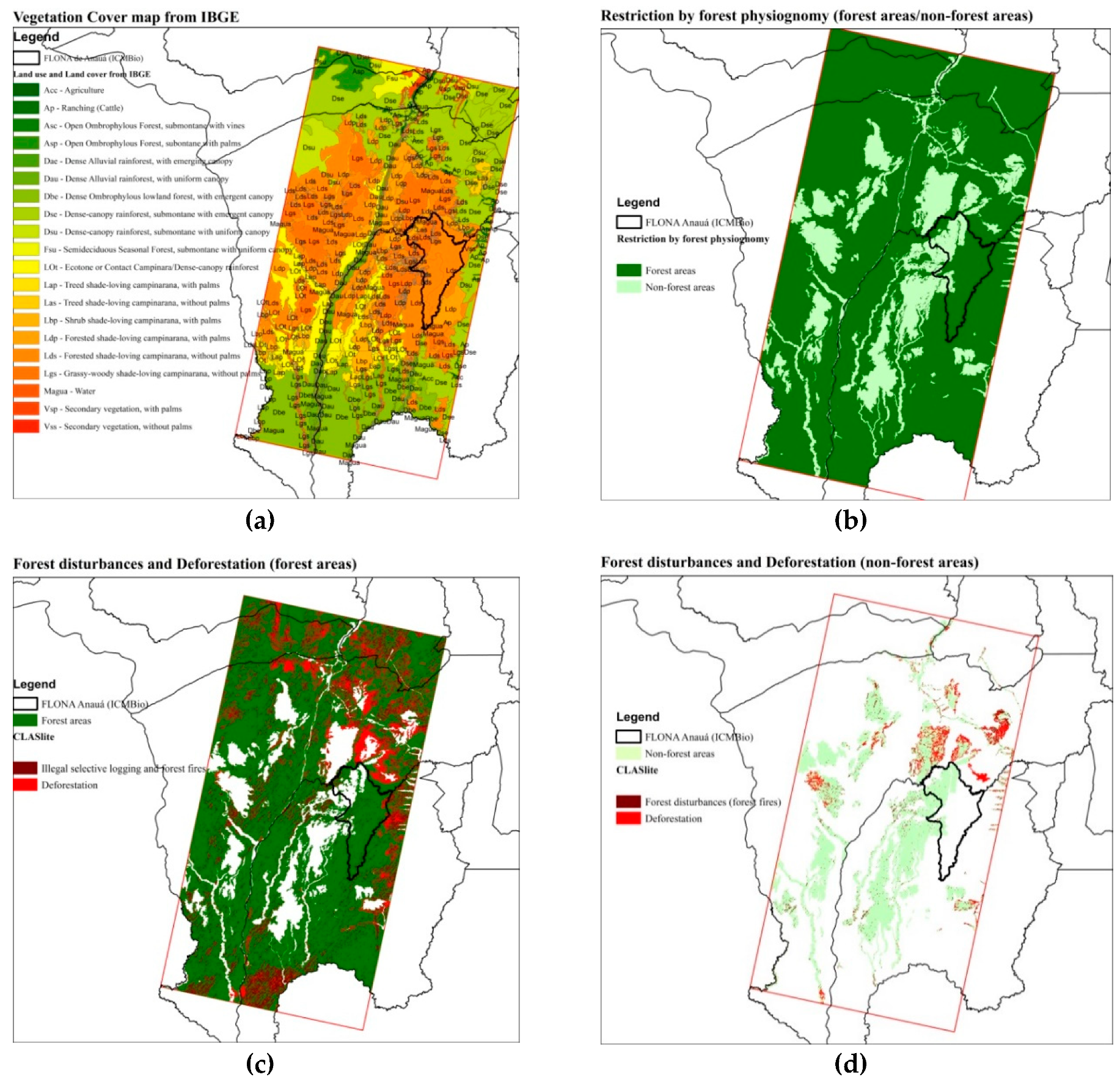
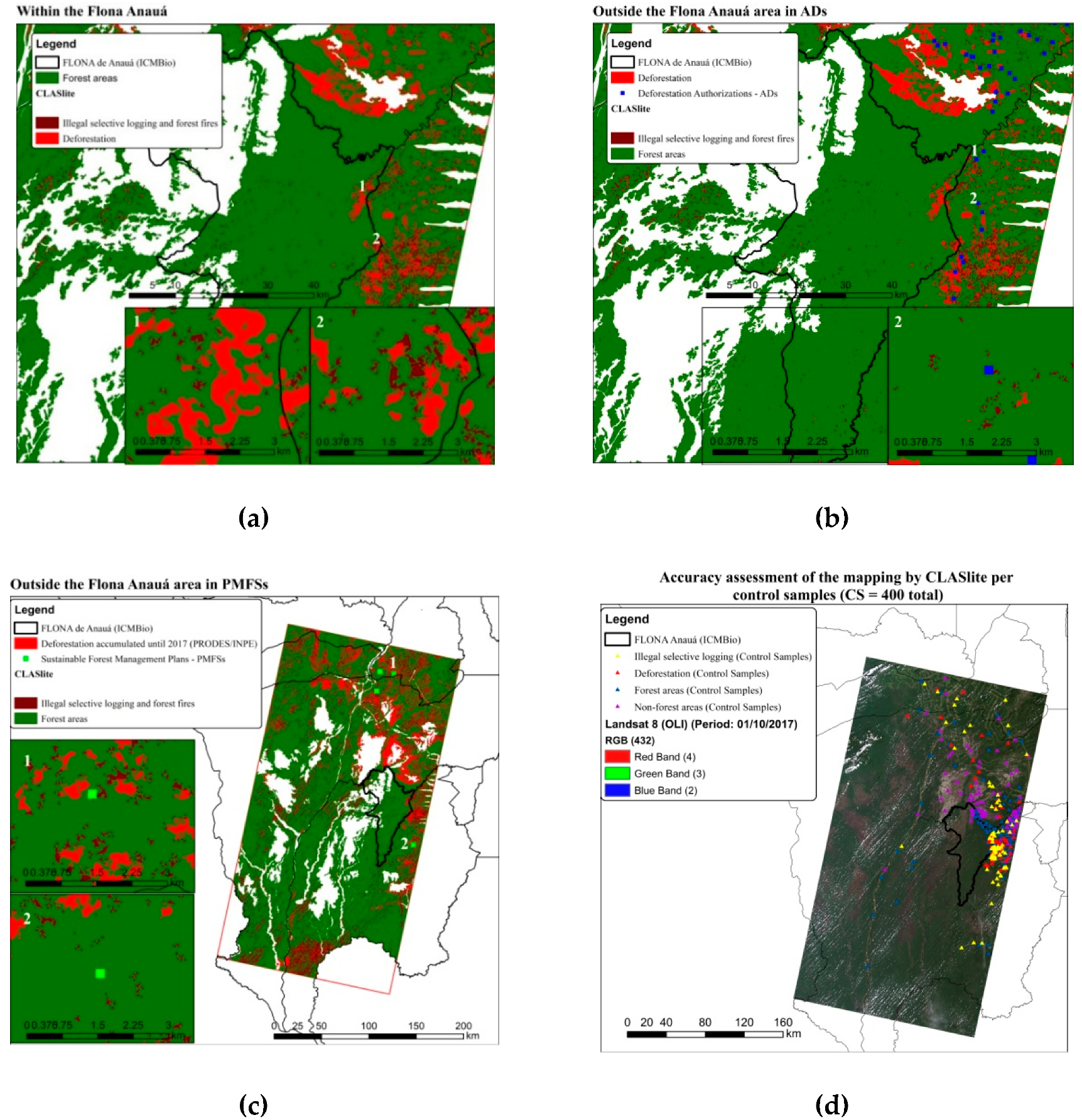
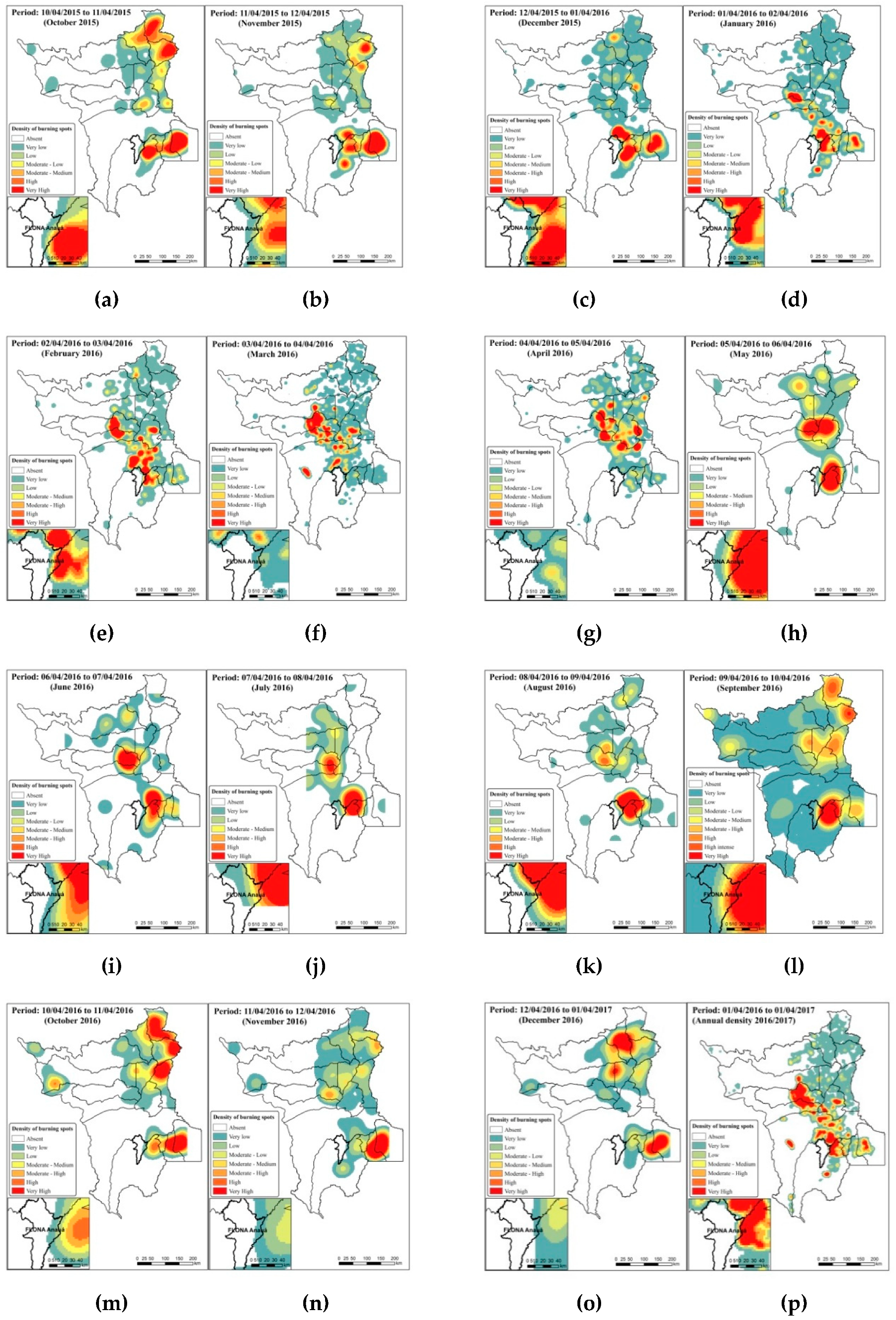
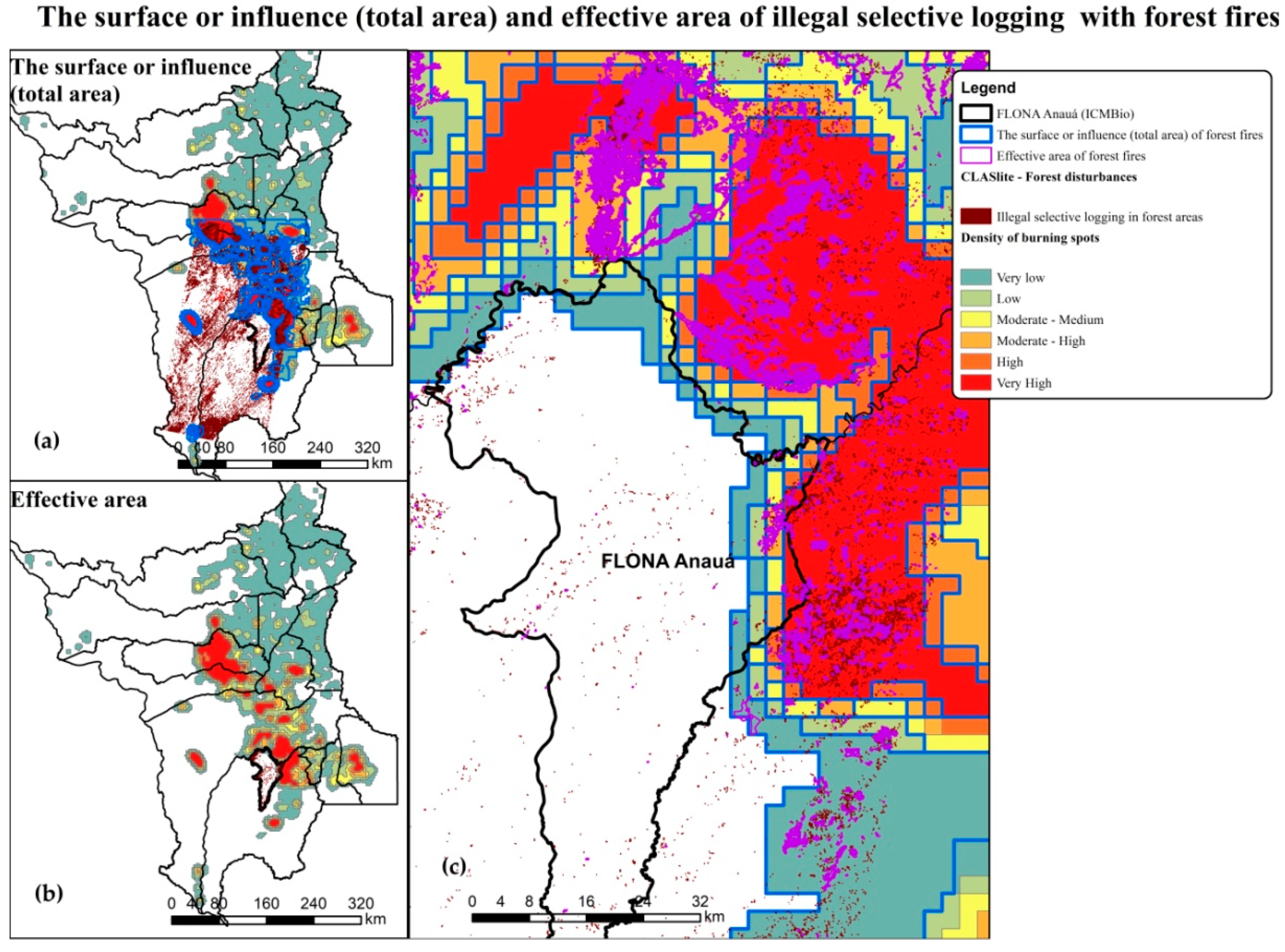

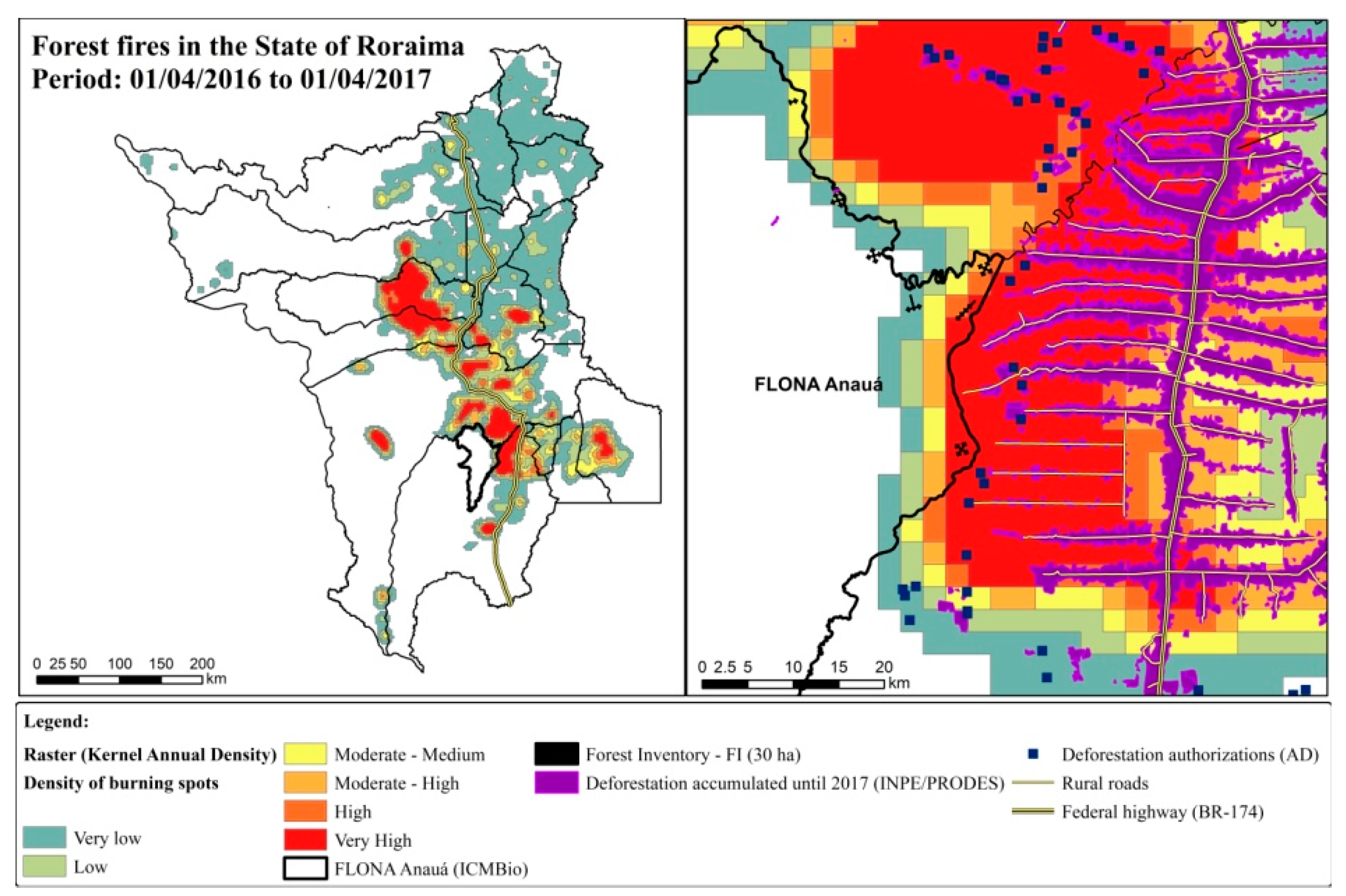
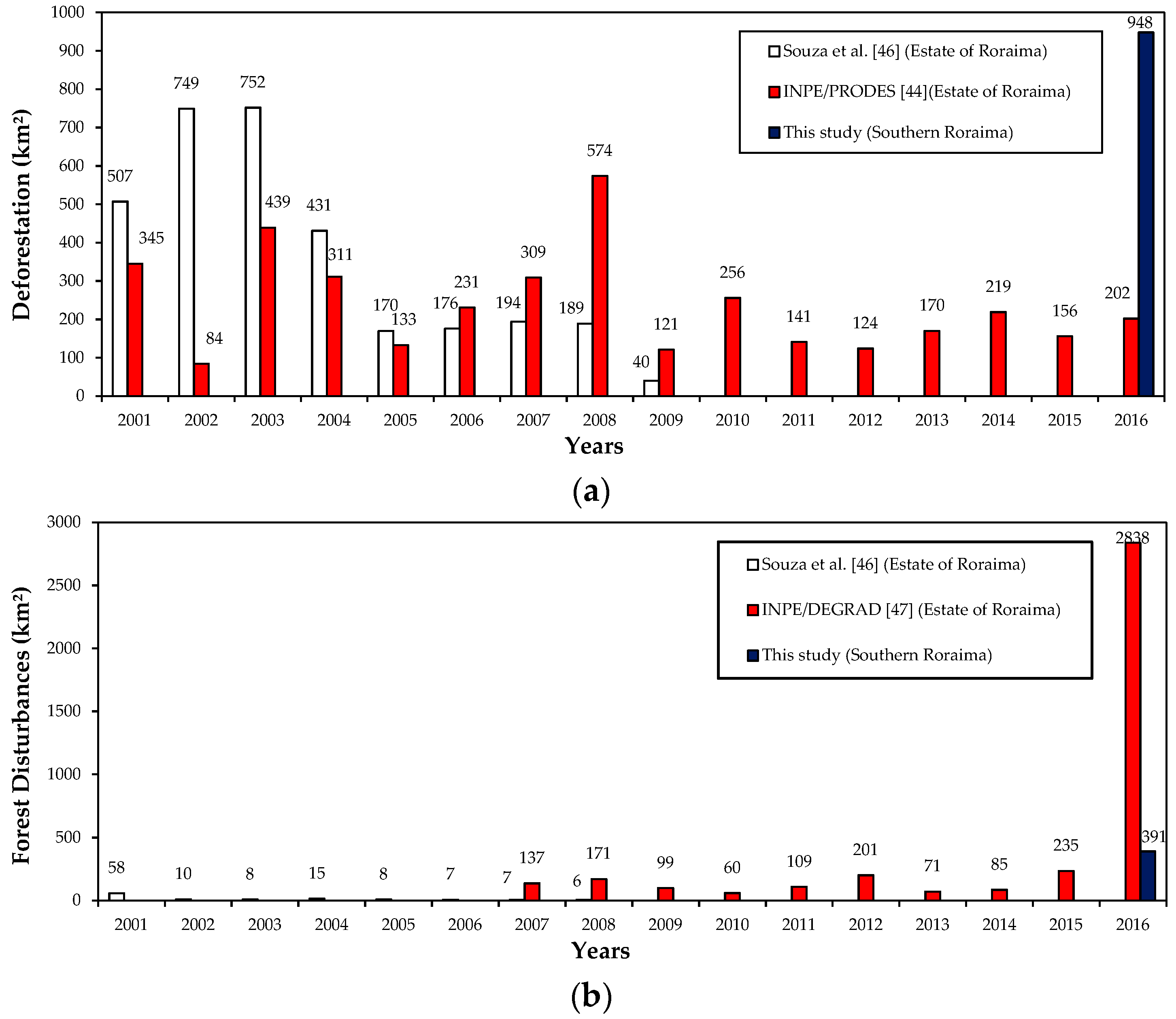
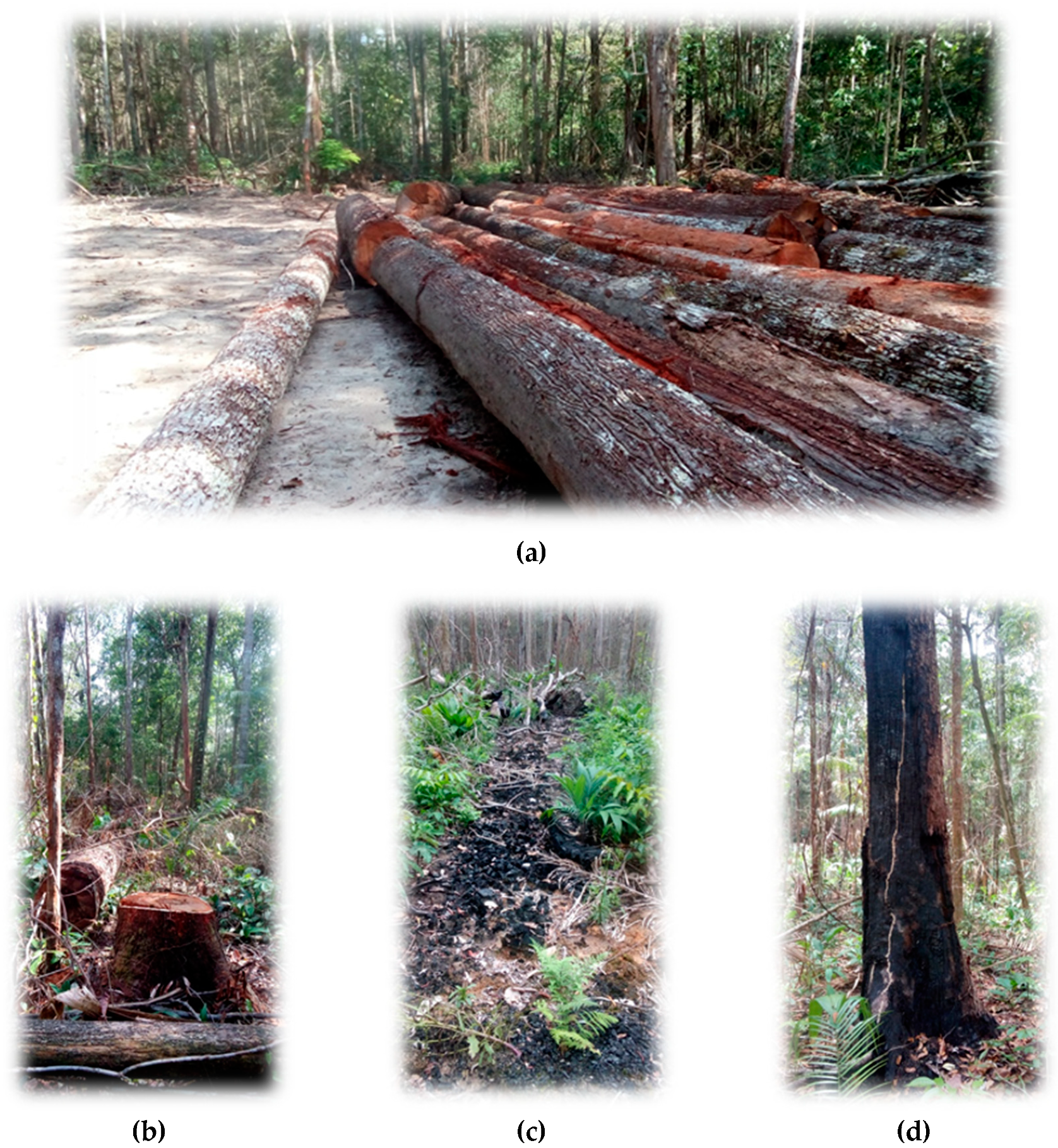
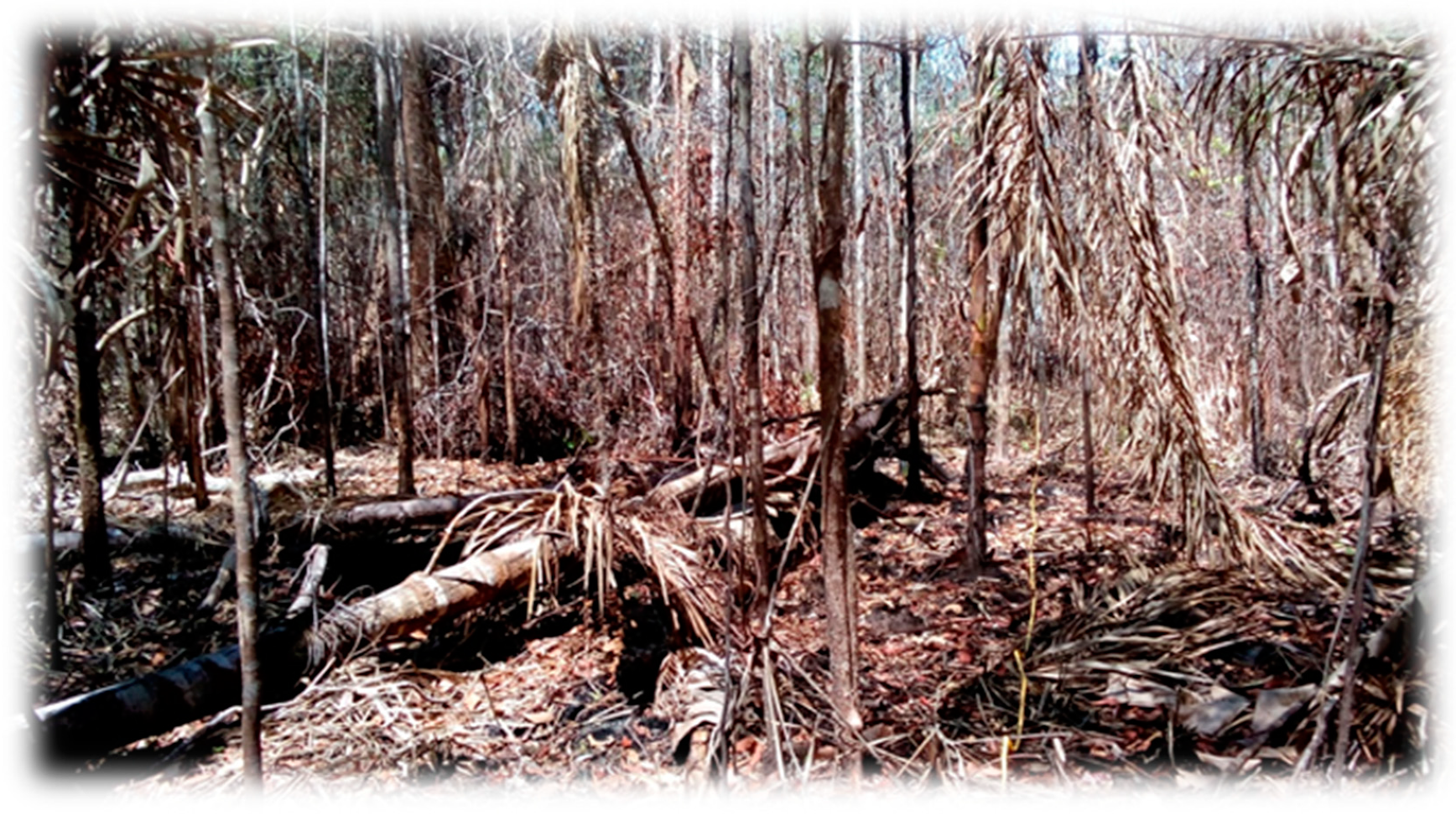
| Forest Phytophysiognomy 1 | Forest Inventory (FI) | Timber Measurement (TM) | |||
|---|---|---|---|---|---|
| Density (trees·ha−1) | DBH (cm) | DBH (cm) | H (m) | Hdom. (m) | |
| LOt ² Forested shade-loving campinarana (Ld)/Dense-canopy rainforest submontane (Ds) | 491 ± 15 | 21 ± 0.3 | 37 ± 5 | 21 ± 1 | 33 ± 1 |
| Description | Tree Mortality | Forest Carbon Stock | |||
|---|---|---|---|---|---|
| Density (Dead Trees·ha−1) | Total Dead Trees in FI (30 ha) | Percentage of the FI (%) | Carbon Losses (Mg ha−1) | Percentage of the FI (%) | |
| Natural Process ¹ | 21 ± 3 | 638 | 4.3 | - | - |
| Human Process ² | 19 ± 9 | 575 | 3.9 | 6 ± 3 | 3.5 |
| Total | 40 ± 9 | 1213 | 8.2 | 6 ± 3 | 3.5 |
| Description | Forest Areas (km²) | Non-Forest Areas (km²) | |||||
|---|---|---|---|---|---|---|---|
| LOt ¹ | Flona Anauá | Mosaic Area | Roraima ² (%) | Flona Anauá | Mosaic Area | Roraima ² (%) | |
| Illegal selective logging and forest fires | 2.8 | 6 | 357 | 0.16 | - | - | - |
| Forest disturbances by forest fires | - | - | - | - | 0.2 | 34 | 0.01 |
| Deforestation | 8 | 8 | 796 | 0.35 | 0.1 | 152 | 0.07 |
| Total | 10.8 | 14 | 1153 | 0.51 | 0.3 | 186 | 0.08 |
| Class ¹ | Validation ² (Ground Truth - In Situ) | Errors (%) | Accuracy (%) | |||||||
|---|---|---|---|---|---|---|---|---|---|---|
| C1 | C2 | C3 | C4 | Total | Commission | Omission | Producer | User | ||
| CLASlite | C1 | 89 | 8 | 0 | 14 | 111 | 20 | 11 | 89 | 80 |
| C2 | 0 | 75 | 0 | 1 | 76 | 1 | 25 | 75 | 99 | |
| C3 | 5 | 12 | 98 | 2 | 117 | 16 | 2 | 98 | 84 | |
| C4 | 6 | 5 | 2 | 83 | 96 | 14 | 17 | 83 | 86 | |
| Total | 100 | 100 | 100 | 100 | 400 | |||||
| Overall Accuracy = 86% | ||||||||||
| Kappa Index = 82% | ||||||||||
© 2019 by the authors. Licensee MDPI, Basel, Switzerland. This article is an open access article distributed under the terms and conditions of the Creative Commons Attribution (CC BY) license (http://creativecommons.org/licenses/by/4.0/).
Share and Cite
M. Condé, T.; Higuchi, N.; J. N. Lima, A. Illegal Selective Logging and Forest Fires in the Northern Brazilian Amazon. Forests 2019, 10, 61. https://doi.org/10.3390/f10010061
M. Condé T, Higuchi N, J. N. Lima A. Illegal Selective Logging and Forest Fires in the Northern Brazilian Amazon. Forests. 2019; 10(1):61. https://doi.org/10.3390/f10010061
Chicago/Turabian StyleM. Condé, Tiago, Niro Higuchi, and Adriano J. N. Lima. 2019. "Illegal Selective Logging and Forest Fires in the Northern Brazilian Amazon" Forests 10, no. 1: 61. https://doi.org/10.3390/f10010061
APA StyleM. Condé, T., Higuchi, N., & J. N. Lima, A. (2019). Illegal Selective Logging and Forest Fires in the Northern Brazilian Amazon. Forests, 10(1), 61. https://doi.org/10.3390/f10010061






